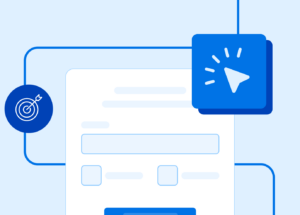Popups are one of the easiest and simplest ways to gather data about your website visitors. From collecting emails to promoting content and generating new leads, popup forms are a strategic addition to your organization’s marketing efforts. But what does your audience really think?
If you’ve ever been frustrated by a popup interrupting your visit to a website, you may think that these forms do more harm than good for your audience. Do popups really work or are people so sick of them that it could be the reason they leave your site? Keep reading for our take on the issue.
Are popup forms a bad practice?
Traditional digital advertising tactics such as large banner ads and popup ads come with mixed reviews, at best. In fact, research shows that “banner blindness,” when information overload causes website visitors to skip reading ads, is a widespread phenomenon. Additionally, popup ads can even hurt a website’s SEO and Google ranking, according to Search Engine Journal.
Popup forms that are irrelevant or generic are going to annoy your audience. A poor user experience with popups will most likely cause them to close the form or worse, cause them to leave your website altogether. Here are the top reasons why people dislike popup forms:
- Too many form fields to fill out
- Irrelevant or inappropriate content
- Poor popup timing
- No clear close button
- Irrelevant content or offer
While many people don’t enjoy any popup that makes it harder to interact with websites, annoying and effective are two different aspects of popups that can be mutually exclusive.
Are popup forms a best practice?
If you’ve ever been frustrated by a popup, you may think these forms do more harm than good for your audience. But with an optimized design and a good offer, popup forms have an 11% average conversion rate. This number is significant, as the average web form only converts about 2% of site visitors.
It might be more aggressive than letting your audience find the CTA themselves, but popup forms really do drive conversions. They make it clear how you want your users to take action and put the ability to do so right in front of them. When designed correctly, popup forms have the opportunity to meet site visitors where they are, provide value, and gather useful data.
Getting your audience’s attention is tough, but popup forms clearly help with lead generation and shouldn’t be overlooked.
Should you add popup forms to your site?
If you’re wondering whether popups are good or bad, the answer is fairly simple. Bad popups can create a poor user experience that risks visitors not converting or leaving your site for good. Good popups can provide value and be an effective lead-generation tool. The trick is finding the healthy balance between using popup forms too much and not at all.
Tips for designing popup forms that convert
Here are our recommendations for creating high-converting popup forms that are not overbearing or irrelevant.
1. Be careful about popup timing
Give people time to read and absorb your content before a popup form triggers on the page. If people took the time to visit one of your blog posts or landing pages, they probably have an interest in your content. Let them start finding value in your content first. They will be more inclined to take action when presented with a popup.
2. Stay away from condescending language
There’s nothing wrong with making your desired course of action sound inviting and actionable to your audience. But be careful about how you phrase the alternative. Some companies go a little too far in making the opt-out sound like a bad decision. Don’t turn off your audience by insulting them. That way you’ll have a better chance of converting them the next time they are on your site.
3. Don’t make it too difficult to close the popup
Likewise, respect people’s decisions if they choose not to engage with your popup form. You’ve probably seen popup forms with small close buttons or buttons that are almost the same color as the form (or maybe even no buttons at all). This can be frustrating for your users and is considered a bad practice. Make it easy for people to close the popup form if that’s what they want to do. It’s better for someone to exit out of a popup than to leave your site completely.
4. Provide an offer users can’t ignore
When people get interrupted, they generally want the interruption to be worth it. If your CTA isn’t strong and compelling, why did you have to bother them in the first place? Your popup forms should provide an offer that is valuable and actionable to the audience you are targeting.
Do you want to grow your email list? Tell users what valuable content they can expect in your newsletter. Looking to sell more of your new product? Offer a special discount for their purchase. Be strategic about the design and copy of your form to show that, despite an interruption, you have something worthwhile to offer your audience.
5. Include only necessary form fields
The highest converting popup forms only have two form fields, according to research completed by Drip, a leading e-commerce marketing automation platform. Add additional fields, and conversion rates drop significantly (down to 0.81% for five form fields). To maximize the chances of collecting an individual’s information, stick with minimal form fields that only request essential data. In most cases, you’ll only need a user’s name and email address.

